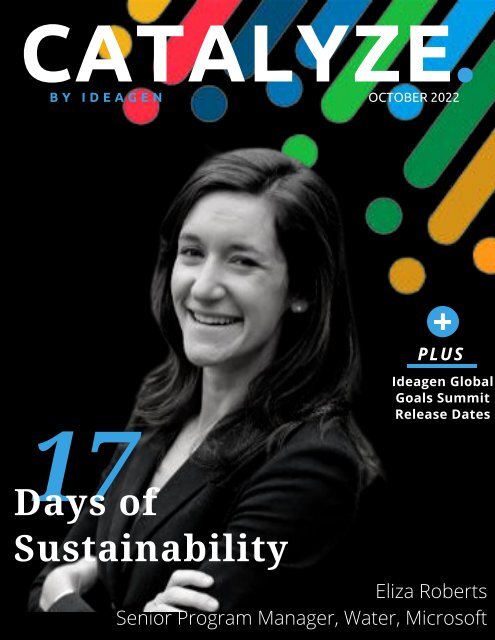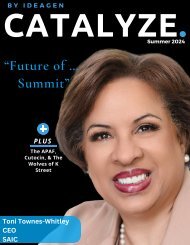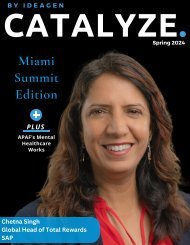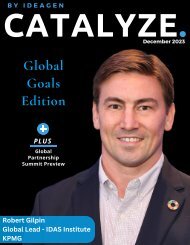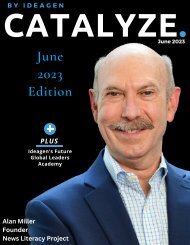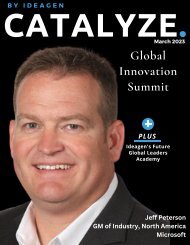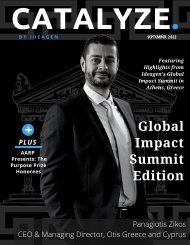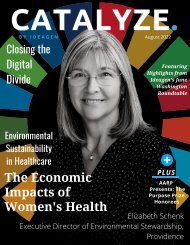Catalyze October
To read the full version visit Ideagenmember.com today!
To read the full version visit Ideagenmember.com today!
You also want an ePaper? Increase the reach of your titles
YUMPU automatically turns print PDFs into web optimized ePapers that Google loves.
CATALYZE.<br />
B Y I D E A G E N OCTOBER 2022<br />
PLUS<br />
17 Days of<br />
Ideagen Global<br />
Goals Summit<br />
Release Dates<br />
Sustainability<br />
Eliza Roberts<br />
Senior Program Manager, Water, Microsoft
CATALYZE.<br />
B Y I D E A G E N OCTOBER 2022<br />
PLUS<br />
17 Days of<br />
Ideagen Global<br />
Goals Summit<br />
Release Dates<br />
Sustainability<br />
Grace Clack<br />
Director of Product Marketing, Microsoft
CATALYZE.<br />
B Y I D E A G E N OCTOBER 2022<br />
PLUS<br />
17 Days of<br />
Ideagen Global<br />
Goals Summit<br />
Release Dates<br />
Sustainability<br />
Evangeline Marzek<br />
CTO of Sustainability, Microsoft
CATALYZE.<br />
B Y I D E A G E N <strong>October</strong> 2022<br />
17 Days of<br />
PLUS<br />
Ideagen Global<br />
Goals Summit<br />
Release Dates<br />
Sustainability<br />
Ashley Haynes-Gaspar<br />
COO of Industry and Business Aplications, Microsoft
CATALYZE.<br />
B Y I D E A G E N <strong>October</strong> 2022<br />
17 Days of<br />
PLUS<br />
Ideagen Global<br />
Goals Summit<br />
Release Dates<br />
Sustainability<br />
Dawn James<br />
Director, Global Industry Strategy, Energy &<br />
Sustainability at microsoft
CATALYZE.<br />
B Y I D E A G E N <strong>October</strong> 2022<br />
17 Days of<br />
PLUS<br />
Ideagen Global<br />
Goals Summit<br />
Release Dates<br />
Sustainability<br />
Terry Myerson<br />
CEO & Co-Founder, Truveta
CATALYZE MAGAZINE | 1<br />
PRIORITIZING SUSTAINABILITY<br />
ASHLEY HAYNES-GASPAR COO OF<br />
INDUSTRY & BUSINESS<br />
APPLICATIONS AT MICROSOFT<br />
Grace Clack:<br />
At Microsoft, we believe we have a responsibility to make a difference and<br />
are committed to the transformation required to meet our environmental<br />
goals while moving our business forward. Let's talk to Ashley to learn more.<br />
Ashley, Before we jp in to talk about sustainability being a growth driver,<br />
can you tell us about the focus on industry and sustainability at Microsoft?<br />
Ashley Haynes Gaspar:<br />
Thanks, Grace. It's so great to be here with you all today. Across Microsoft,<br />
we are focusing on industry. We are investing in people in engineering and<br />
customer engagements and partner networks with a deep focus on how<br />
we can help our customers lower carbon emissions, use less potable water,<br />
and create more sustainable supply chains. You know, it doesn't matter if<br />
you're a manufacturer or a retailer in sports and entertainment, travel and<br />
transport, financial services, or health care. We are doing this work across<br />
industries and the business case for sustainability is strong. A recent study<br />
by Deloitte found that strong climate action can deliver 43 trillion. That's<br />
trillion with a T, US dollars to the global economy by 2070. So the time is<br />
now.
PRIORITIZING<br />
SUSTAINABILITY<br />
GRACE CLACK:<br />
DIRECTOR OF<br />
PRODUCT<br />
MARKETING<br />
MICROSOFT<br />
Ashley Haynes Gaspar:<br />
Sure. From where I sit, not only is prioritizing sustainability the right thing for the<br />
environment and the planet, but organizations are feeling the pressure of change<br />
from every direction. There has been a shift from, I think, what we traditionally<br />
thought about as shareholder capitalism to this notion of stakeholder capitalism.<br />
You know, the decades preceding this was all about shareholder return. Most, if<br />
not all decisions were anchored on this as the key tenant. And I think we've seen a<br />
shift to stakeholder capitalism, a model where the shareholder still absolutely<br />
matters, but so do customers and employees. So does the community that the<br />
company operates in. And what I'd love to do is just kind of break that down really<br />
quickly, Grace. Investors are putting financial pressure on organizations that have<br />
not made carbon pledges. They are voting with their values. 73% say that efforts to<br />
improve the environment and society contribute to their investment decisions. I<br />
think that this is a shift from where we've been<br />
customers.<br />
Customers are voting with their values. With 77% of consumers motivated to<br />
purchase from companies committed to making the world a better place. It's why<br />
I love Bombas socks. It's why I pay more for them. When we think about regulators,<br />
regulators raise public reporting expectations and tighten controls and employees.<br />
Employees want to work for an organization that is making a difference in creating<br />
a sustainable future. In fact, the data says that 93% of employees believe<br />
companies have to lead with purpose. And I think this shift from stakeholder to<br />
shareholder is just really an existential priority for us.<br />
CATALYZE MAGAZINE | 2
REDUCE, REPLENISH, AND<br />
REPORT<br />
-HOW MICROSOFT IS MAKING A DIFFERENCE IN<br />
WATER USAGE<br />
ELIZA ROBERTS: SENIOR PROGRAM<br />
MANAGER, WATER AT MICROSOFT<br />
Eliza Roberts<br />
Microsoft is committed to harnessing the power of technology to help<br />
everyone everywhere build a more sustainable future. In 2020, we made a<br />
bold commitment and detailed plan to become carbon-negative by 2030 0,<br />
waste by 2030, water positive by 2030, protect more land than we use, and<br />
build a planetary computer. So I'm gonna start a little bit dire here, but I<br />
promise to end on a more positive note. Water challenges are going to<br />
become more extreme. We know that one of the first ways we'll feel the<br />
effects of climate change is through water. And it's important to remember<br />
before I dive in here, that when we're talking about water, we're not just<br />
talking about water scarcity or whether there's too little water. There are<br />
also places where there's too much water and other places where it's too<br />
dirty or polluted. So, too little, too much, too polluted, and that helps make<br />
the water challenges that we're grappling with much more complex and<br />
challenging on a day-to-day basis. Many of you have probably heard this<br />
stat, but the world is expected to face a 56% deficit in freshwater supply by<br />
2030. According to the World Resources Institute today, one in four people<br />
live in countries facing extreme water stress according to the UN, and that's<br />
expected to increase to one in two people, in 2030 and beyond. Today, there<br />
are about 2 billion people across the globe or 25% of the world's population<br />
who lack safely managed drinking water services.<br />
CATALYZE MAGAZINE | 3
REDUCE, REPLENISH, AND<br />
REPORT<br />
Eliza Roberts<br />
The costs that we need to improve global water infrastructure globally are<br />
staggering. There's a range of different numbers, but they're in the trillions<br />
and they're really expected to rise in time. And to put this in perspective, if<br />
you look at the US alone, each day, 6 billion gallons of water are lost to aging<br />
leaking pipes. That's roughly 14% of our daily consumption. So we know we<br />
have a challenge, we know it's increasing, we know we all depend on water<br />
to survive, and thus there's a really important role for all of us, particularly<br />
companies to play in protecting freshwater resources for future generations.<br />
That is why Microsoft co-founded the Water Resilience Coalition, which I'll<br />
refer to as the WRC, and that's a CEO-led initiative that's a part of the UN<br />
global compact with a goal to reduce water stress by 2050. So we joined the<br />
Water Resilience Coalition in 2005 and we're still an active member. And<br />
then as a part of that, we also set a commitment to be water positive by<br />
2030. So water positive is a new term. It still requires more clarity and<br />
guidance in this space, and we're helping to develop that.<br />
In the meantime, I want to share a bit about<br />
what water-positive means to Microsoft. So in<br />
Microsoft Water positive means, we will<br />
reduce our water use intensity across our<br />
operations. The water we use per megawatt<br />
of energy used for operations, we will<br />
replenish water in water stress regions where<br />
we work more than we consume. By 2030, we<br />
will provide 1.5 million people with access to<br />
clean water and sanitation services, and we'll<br />
drive innovation and digitization of water and<br />
engage in water policy for today.<br />
CATALYZE MAGAZINE | 4
REDUCE, REPLENISH, AND<br />
REPORT<br />
We're working to reduce the water intensity of our global operations.<br />
We're doing this through investment in efficiency, recycling and reuse, and<br />
investment in innovations at data centers and campuses across the globe.<br />
We are working to design buildings and data centers to be as efficient as<br />
possible. We're tracking the water we use to minimize leaks. We're reusing<br />
every drop of water as many times as we can before we discharge it to<br />
local municipalities. We're procuring reclaimed water from utilities where<br />
it's available. We're rainwater harvesting. On the innovation side, we're<br />
using air instead of water to cool data centers. And we're piloting<br />
increasing the temperature set point at evaporative cool data centers to<br />
ensure that we're using air to cool data centers instead of water for more<br />
days of the year. We're the first technology company to pilot liquid<br />
immersion cooling at data centers. We're piloting air-to-water generation<br />
and building rainwater harvesting structures on our buildings and data<br />
centers.<br />
Next, I want to dive into replenishment. So replenishment is something<br />
that a lot of people get confused about. So I'll start with our target and<br />
then explain a little bit about what it means. So we are committed to<br />
replenishing more water in high-stress regions that we consume globally.<br />
Replenishment ultimately means that we return a volume of water to the<br />
local catchment where it came from. So through this target, we're<br />
planning to return more water than we use across our global operations. In<br />
the high-stress basins where we operate, we've got roughly 40 priority<br />
locations across the globe that are particularly high stress where we plan<br />
to focus these replenishment investments. I'm not gonna share specific<br />
projects at this time. In the interest of time, if you're curious to learn more,<br />
I would encourage you to check out our sustainability report from last year<br />
and other information that we have online.<br />
CATALYZE MAGAZINE | 5
REDUCE, REPLENISH, AND<br />
REPORT<br />
Lastly, I'll share a little bit about our progress and the different types of<br />
replenishment projects that we invest in across the globe. So you can<br />
invest in projects like rainwater harvesting, do land conservation projects<br />
where you procure a swath of land, keep it from being developed, and<br />
then the rain that falls on that land is recharged into the system. There are<br />
infrastructure projects. There are watershed restoration projects. If you're<br />
curious to learn more about the different types of projects, you can check<br />
out the volumetric water benefit accounting guidance feed WRA that was<br />
put out by the World's Resources Institute. It provides different categories<br />
for the many different types of replenishment projects that companies can<br />
invest in. And information about how you quantify the volumetric benefits<br />
for each of those different types of replenishment projects. So our progress<br />
for replenishment thus far as of Y 21, we've replenished 45% of our Y21<br />
consumption. This percentage is just going to keep increasing as we get<br />
closer to 2030.<br />
CATALYZE MAGAZINE | 6
Ideagen®<br />
Global Goals Summit<br />
<strong>October</strong> 27, 2022<br />
Hosted at the United Nations<br />
Streaming World Wide Release<br />
November 17, 2022 -<br />
IdeagenGlobal.com<br />
Presented Globally by
To learn more
Microsoft Partnerships<br />
Leading To<br />
Sustainability<br />
DAWN JAMES: DIRECTOR, GLOBAL INDUSTRY<br />
STRATEGY- ENERGY & SUSTAINABILITY AT<br />
MICROSOFT<br />
Dawn James:<br />
So at Microsoft, we've really focused our strategy on the core issues that we think<br />
are critical to a more sustainable future. And this is where we really believe that<br />
technology can play a pivotal role. We focus our efforts on carbon, water, waste,<br />
and ecosystems, or really anywhere. where we see that digital technology can help<br />
to monitor and help the biota. So at Microsoft, we're really focused on investing our<br />
time and resources into building the world's leading platform for technology<br />
solutions and environmental challenges. The way that we do that is we really, look<br />
at infusing sustainability into all of our products and services, being not only that<br />
preferred platform but also being able to transparently share our learnings and<br />
pass that sustainability gains onto our customers. We look at how we can truly be<br />
that trusted partner for our customer's sustainability journey and share all of the<br />
things that we've learned in our long history of supporting sustainability initiatives.<br />
We advocate for climate-related policy and issues to support not only new policy<br />
initiatives but also to accelerate the growth of sustainability-related action. We<br />
also look to truly infuse sustainability into all of our operations across our business,<br />
and our value lines. And we look to not only science but also the international<br />
goals that we need to adhere to. And we do this in a transparent way by holding<br />
ourselves accountable for our goals. And at the heart of everything that we do is<br />
our employees. So we truly believe that even if sustainability isn't in your title,<br />
sustainability is everybody's job and everybody has a role to play.<br />
CATALYZE MAGAZINE | 8
CATALYZE MAGAZINE | 9<br />
3 Key Components That Will Make<br />
Your Organization More<br />
Sustainable<br />
EVANGELINE MARZEC:<br />
CTO, SUSTAINABILITY AT MICROSOFT<br />
Evangeline Marzec:<br />
In your own organization today, there are likely opportunities to proactively make<br />
changes in these areas to hit your sustainability targets. These things are under your<br />
direct control. First, by their very nature, buildings are a big contributor to our<br />
environmental footprint, and it's the first place that many organizations turn to in<br />
order to understand and reduce impact through optimization and efficiency<br />
solutions. In North America, residential and commercial buildings consume an<br />
estimated 40% of total US energy generation. The World Green Business Council<br />
estimates that every building on the planet must be net zero carbon by 2050 in<br />
order to keep global warming below 1.5 degrees C . Yet less than 1% of the global<br />
building stock meets the standard at Microsoft. Our data centers in total generate<br />
210 grams of carbon dioxide equivalent per user equivalent to driving about a<br />
kilometer. But to reach net zero, we're working with our partners like Johnson<br />
Controls, to design embodied carbon out of our buildings and manage their energy<br />
efficiency in new ways.<br />
Second, examine the footprint of your products. It's probably bigger than you think.<br />
The take, make waste approach to consuming, using and disposing of materials and<br />
products simply isn't sustainable. We need to shift to a circular economy, which<br />
promotes the elimination of waste and the continued safe use of natural resources.<br />
For example, one of our teams investigated one of the best selling technology<br />
products of all time the Microsoft Mouse, and was able to redesign it to use 20%<br />
reclaimed ocean plastic.
3 KEY COMPONENTS THAT WILL<br />
MAKE YOUR ORGANIZATION<br />
MORE SUSTAINABLE<br />
E V A N G E L I N E M A R Z E C<br />
More organizations are embracing transparency on the footprint of their<br />
products today, while others are introducing new products designed to be<br />
circular or low carbon. Admittedly, today, it's still hard to get credit for these<br />
changes, give the current standards, and it's still harder to calculate the<br />
product level emissions across complex value chains.<br />
Third, look at the activities of your people and how they're contributing to<br />
your carbon footprint. New video conferencing and collaborative work<br />
solutions have begun to lower the footprint from travel and new approaches,<br />
including low carbon fuels, exist such as the sustainable jet fuel used in<br />
partnership between Microsoft and Alaska Airlines. We know this data is still<br />
hard to obtain, even internal , if we know this data is still hard to obtain even<br />
internally, and it's hard to measure the impact of adoption.<br />
We often take a sampling approach, for example, by hosting one Microsoft<br />
event for more than 2000 attendees, virtually as compared to in person.<br />
We've estimated that we lowered the carbon emissions associated with that<br />
event by nearly 5,000 metric tons. That's equivalent to the amount of carbon<br />
absorbed over 10 years by planting nearly 150 acres of forest. The road ahead<br />
contains enormous complexities and challenges. We can best walk it<br />
together with practicality, ingenuity, and a growth mindset open to learning,<br />
and sharing. Thank you for joining me on this journey.<br />
CATALYZE MAGAZINE | 10
CATALYZE MAGAZINE | 11<br />
A BACKGROUND IN<br />
ORGANZING THE<br />
COUNTRIES HEALTHCARE<br />
DATA<br />
BJ Moore<br />
CIO and EVP of Real Estate Strategy and Operations at Providence<br />
Terry Meyerson:<br />
CEO & Co-Founder at Truveta<br />
BJ Moore:<br />
At Providence, we've got a massive amount of data and electronic health record<br />
information from the pandemic. Unfortunately, it was spread across multiple<br />
sources of data housing. So joining up with Truvada was a benefit because not<br />
only were we able to consolidate all of our health data, but you've brought<br />
additional data sources that have enriched our data, right? You've added<br />
“Truveta insights” to bring in data sets that we weren't bringing in that have<br />
really supplemented our own knowledge of medical health systems. So it's more<br />
than just taking our electronic health record data and consolidating it, it's<br />
enriching it.<br />
Terry Myerson<br />
Yeah, it is really interesting to see how health data is distributed and understand<br />
its outcomes. I think one of the more clear outcomes we often look at in health<br />
systems candidly is did the individual die? And for that, you need what's in the<br />
industry known as the fact of death, which can come from the Social Security<br />
Administration, credit bureaus, and numerous other organizations.
CATALYZE MAGAZINE | 12<br />
A BACKGROUND IN ORGANZING THE COUNTRIES<br />
HEALTHCARE DATA CONTINUED...<br />
So, much of what drives health outcomes is socioeconomic status. We know this<br />
through what's called claims data, or the medical bills that insurers pay.<br />
Providence has this incredible data set for all the treatments they provide.<br />
However, they don't have data from other healthcare providers. For example, I<br />
sometimes get care at Virginia Mason or a local community provider, which<br />
happens to be a Truveta member as part of our Common Spirit affiliation. Now<br />
with Providence being a Truveta member; Providence researchers can see the<br />
care at Virginia Mason or any other healthcare provider that's also a Common<br />
Spirit member. This gives providence researchers access to the data we talked<br />
about earlier like the fact of death, or claims data without wasting time on<br />
lengthy data research or wading through masses of cloudy data.<br />
BJ Moore:<br />
And the progress your team has made Terry in two years is just fantastic. You<br />
think about any other tech company that starts two years ago in the middle of<br />
the pandemic and the progress you've made is really just scratching the surface<br />
of Truveta’s total potential value.
I D E A G E N ' S P O W E R 1 0 L I S T<br />
10 global leaders who are Changing the World in 2022<br />
Mark Fitzgerald<br />
KPMG<br />
Barb Quaintance<br />
AARP<br />
Steve Israel<br />
Michael Best<br />
Strategies<br />
Dr. Sidhant Gupta<br />
Microsoft<br />
Tomas Thyblad<br />
Nasdaq<br />
Microsoft<br />
Ashley Haynes-Gaspar<br />
Peggy Pelonis<br />
ACS Athens<br />
Jake Herway<br />
Gallup<br />
BJ Moore<br />
Providence<br />
Nick Larigakis<br />
American Hellenic<br />
Institute<br />
CATALYZE MAGAZINE | 13
Editor's Note<br />
Dear Ideagen Global Friends and Colleagues,<br />
As we prepare for the September 8th release of the Ideagen Global<br />
Impact Summit and 17 Days of Sustainability in <strong>October</strong>, Ideagen<br />
Global continues to maximize our efforts with a relentless commitment<br />
to convene the world's greatest minds from the world's leading<br />
companies, NGOs, and the public sector to address the world's most<br />
vexing issues. In 2022, Ideagen TV content will again reach over 100<br />
Million People across the planet with our ubiquitous content<br />
distribution, including inspiring interviews and custom programming to<br />
create awareness and Global Partnerships to Achieve the Goals.<br />
2022 is already an #EPIC year with high-impact hybrid/live events<br />
across the planet, including Athens, Greece, New York, and many other<br />
global destinations! Join the movement at IdeagenGlobal.com for all of<br />
the latest updates.<br />
Sincerely,<br />
GEORGE SIFAKIS<br />
GEORGE SIFAKIS<br />
Editor-in-Chief & CEO<br />
Ideagen<br />
CATALYZE MAGAZINE | 24<br />
COOPER HENDERSON<br />
Lead Publication Editor<br />
DANIEL KERNS<br />
Co-Editor and Chief of Staff<br />
WILL MARTIN<br />
Co-Editor and Senior Fellow<br />
Pictured Top to Bottom<br />
Microsoft's Tilemachos Moraitis<br />
ACS Athens's Peggy Pelonis<br />
Amb. Angelos Pangratis (ret.)<br />
Top Left: Ideagen's Global Impact Summit


